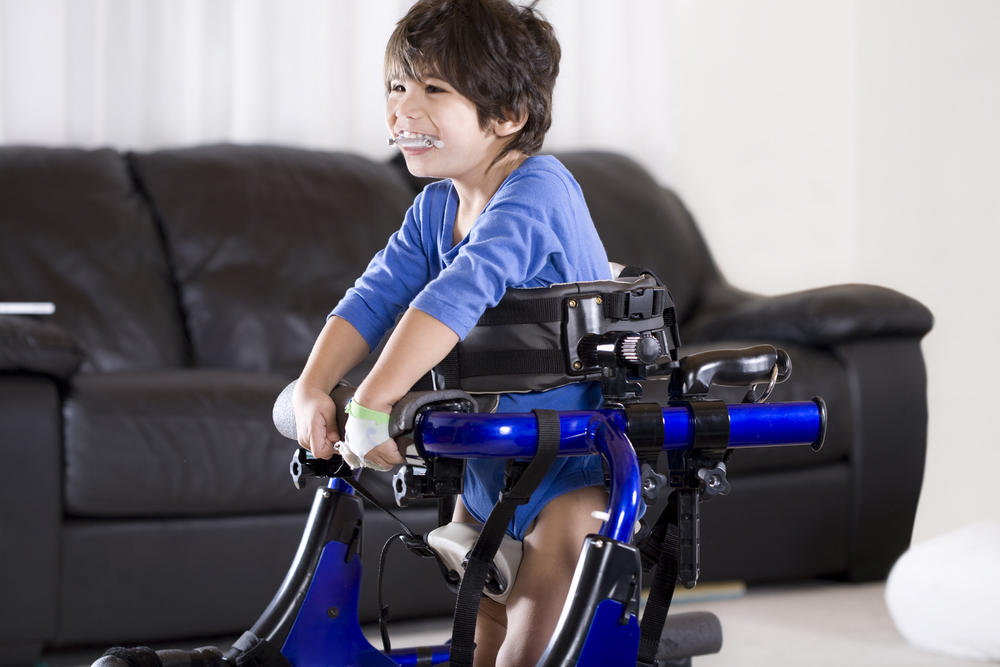Understanding Erb’s Palsy and Its Therapeutic Management

Understanding Erb’s Palsy and Its Therapeutic Management
Defining Erb’s Palsy and Its Impact on Movement
Erb’s Palsy, also known as brachial plexus birth palsy, is a condition that arises from nerve damage during childbirth, particularly when the baby’s neck is stretched to one side. This injury affects the brachial plexus, the nerve network responsible for movement and sensation in the shoulder, arm, and hand. The severity of Erb’s Palsy can range from mild weakness to complete paralysis of the affected limb.
Risk factors for this condition include birth weight over 9 pounds, maternal gestational diabetes, and breech positioning during delivery. These factors can increase the likelihood of a difficult birth, leading to a higher risk of nerve damage. Without timely and appropriate intervention, individuals with Erb’s Palsy may face significant challenges in reaching, grasping, and performing daily activities, potentially resulting in a lifetime of disability.
Early diagnosis and treatment are crucial for improving outcomes. Pediatricians typically screen for signs of brachial plexus injury immediately after birth, such as arm paralysis or lack of reflexes. If an injury is suspected, referrals to pediatric neurologists and orthopedic specialists are made to confirm the diagnosis and begin the recovery process.
The Role of Physical and Occupational Therapy in Recovery
Physical and occupational therapy play a pivotal role in the recovery process for individuals with Erb’s Palsy. These therapies are tailored to improve movement and function affected by the condition. Initially, a physical therapist may introduce exercises to be performed at home, which are crucial for the child’s improvement. These exercises often include:
- Passive range of motion to prevent contractures
- Massage to decrease muscle spasms
- Stretching to maintain flexibility
As the child progresses, the focus shifts to strengthening intact nerves and stimulating damaged ones through specialized treatment programs. Occupational therapy becomes particularly important as it helps in:
- Improving coordination, reach, and grasp
- Adapting daily activities to enhance participation in school and social settings
For more severe cases, a multidisciplinary team of specialists, including neurosurgeons and orthopedic surgeons, may be involved to complement the therapy with medical interventions. The ultimate goal of both physical and occupational therapy is to maximize the child’s functional abilities and ensure the best possible outcome.
Setting Realistic Goals and Expectations for Therapy
In the journey of recovery from Erb’s Palsy, setting realistic goals and expectations is a cornerstone of effective therapy. It is essential to collaborate with a multidisciplinary care team, including educational experts, neurologists, nutritionists, and therapists, to establish achievable objectives tailored to the child’s unique situation. These professionals provide invaluable guidance in understanding the potential outcomes and crafting a personalized care plan.
Goals should encompass both short-term milestones, such as improving nutritional intake to support overall health, and long-term aspirations like achieving independent living or vocational success. While the ultimate aim is to support a life that is as comfortable and fulfilling as possible, it is important to recognize that goals may evolve over time:
- Initially, focus on immediate health-related targets.
- Gradually incorporate objectives that foster self-reliance and independence.
- Regularly reassess and adjust goals to align with the child’s growth and changing needs.
Parents play a critical role in this process, not only by providing emotional support and security but also by encouraging their child’s participation in goal-setting as they mature. This collaborative approach ensures that the child’s voice is heard and that their personal desires for the future are respected and integrated into the therapy plan.
Essential Physical Therapy Techniques for Erb’s Palsy
Passive Range of Motion Exercises
Passive range of motion (ROM) exercises are a cornerstone of physical therapy for Erb’s Palsy recovery. These exercises involve moving the affected limb through its full range of motion without the use of the child’s muscles. The primary goal is to maintain joint flexibility and prevent the development of contractures, which are permanent tightenings of the muscle or joint.
- Therapists gently move the child’s arm through various positions to promote joint health and muscle length.
- Consistency is key, with exercises typically performed several times a day to ensure joints remain loose and mobile.
- As the child progresses, these exercises may become more dynamic, incorporating active assistance from the child as their strength and control improve.
Passive ROM exercises lay the foundation for more advanced therapeutic activities aimed at restoring function and strength to the affected limb. They are often complemented by other techniques such as massage and stretching, which further aid in maintaining muscle flexibility and reducing spasm.
Massage and Muscle Spasm Management
In the journey to recovery from Erb’s Palsy, massage therapy plays a crucial role in managing muscle spasms and promoting relaxation of the affected muscles. This technique is particularly beneficial in reducing the discomfort associated with muscle tightness and in enhancing circulation to the impacted area. Therapists may employ various massage modalities tailored to the individual’s condition and response to treatment.
Key aspects of massage therapy for Erb’s Palsy include:
- Gentle kneading and stroking motions to alleviate muscle tension
- Trigger point therapy to address specific areas of muscle spasm
- Myofascial release to improve soft tissue mobility
Alongside massage, muscle spasm management often involves the use of muscle relaxants. These medications can temporarily reduce overactivity in muscles, preventing further complications and facilitating a more effective physical therapy regimen. It is essential, however, to balance the use of these medications with therapeutic exercises to ensure progress in recovery.
Stretching for Flexibility and Function
In the journey to regain movement and function in individuals with Erb’s Palsy, stretching plays a pivotal role. It is essential for maintaining flexibility in the affected limb and preventing the development of contractures, which are permanent tightenings of the muscle and tissue. Stretching exercises are carefully designed to target specific muscle groups that may be impacted, such as the biceps, triceps, and wrist flexors.
- Gentle stretching is initiated to enhance the elasticity of muscles and connective tissues, promoting better range of motion.
- Sustained stretches are often recommended to lengthen the muscle fibers and increase flexibility over time.
- Dynamic stretching may also be incorporated to prepare the muscles for more active movements and therapy exercises.
Therapists work closely with patients to ensure that stretches are performed correctly and consistently. The goal is to integrate these stretches into a daily routine, allowing for gradual improvement in the limb’s function and the patient’s overall mobility. As therapy progresses, the intensity and complexity of stretching exercises can be adjusted to match the individual’s recovery pace and therapeutic goals.
Functional Electric Stimulation for Nerve Recovery
Functional electric stimulation (FES) is a technique that plays a pivotal role in the recovery process for individuals with Erb’s Palsy. This method involves the use of low-level electrical currents to activate nerves in the affected arm, promoting muscle contraction and enhancing nerve repair. The process typically follows a structured approach:
- Physical Evaluation: Before initiating FES, a thorough physical examination is conducted to assess arm movement and identify the specific nerves that have been damaged.
- Electrical Tests: EMG and nerve conduction studies provide objective data that help tailor the FES treatment to the patient’s unique condition.
- Stimulation Protocol: A customized stimulation protocol is developed, which includes the frequency, intensity, and duration of the electrical impulses.
- Therapeutic Exercises: Alongside FES, patients engage in therapeutic exercises designed to complement the stimulation and encourage functional improvements.
- Progress Monitoring: Regular monitoring of muscle strength and nerve function is essential to adjust the treatment plan as needed for optimal recovery.
FES is often integrated with other therapeutic techniques, such as passive range of motion exercises and massage, to provide a comprehensive treatment plan. The goal is to restore as much function as possible and improve the patient’s ability to perform daily activities. For those seeking additional support, a national group of birth injury lawyers offers legal consultation and representation, with a mission to help families affected by birth injuries.
Advanced Occupational Therapy Strategies
Improving Coordination, Reach, and Grasp
Occupational therapy plays a crucial role in enhancing the fine motor skills and dexterity of individuals with Erb’s Palsy. Therapists employ a variety of techniques to improve coordination, reach, and grasp, which are essential for performing daily activities independently.
- Sensory Integration: Therapists may use sensory-rich activities to help patients better integrate and process sensory information, which is vital for coordinated movement.
- Task-Specific Training: Engaging in repetitive, task-specific exercises helps to reinforce motor patterns and improve the efficiency of movements.
- Strength Training: Building up the strength in affected muscles is important for improving grasp and overall arm function.
Therapists also focus on adaptive strategies to enable children to participate more fully in school and social activities. This includes the use of assistive devices or modifying tasks to make them more accessible. The ultimate goal is to foster independence and enhance the quality of life for those affected by Erb’s Palsy.
Adaptive Techniques for School and Social Participation
Children with Erb’s palsy may face unique challenges in school and social settings due to their physical limitations. Adaptive techniques are crucial in helping these children participate fully in academic and social activities.
- Encouraging socialization is vital for children with Erb’s palsy. Goals should be set to help them interact positively with family, friends, and peers. This can include participation in group activities, learning to navigate social cues, and fostering friendships.
- Educational goals must be tailored to accommodate any cognitive or physical impairments. This may involve the use of assistive technology, specialized seating arrangements, or individualized education programs (IEPs) to ensure that the child receives an appropriate education.
- Improving communication is another key area. For children whose condition affects their vocal cords, alternative methods of communication such as Augmentative and Alternative Communication (AAC) may be necessary. This enables them to express themselves and engage with their peers more effectively.
By implementing these adaptive techniques, children with Erb’s palsy can enjoy a more inclusive and fulfilling school experience, paving the way for improved self-esteem and social skills.
Customized Treatment Programs for Individual Needs
Every individual with Erb’s Palsy has unique challenges and recovery trajectories, necessitating personalized treatment programs. Occupational therapists collaborate closely with patients, families, and other healthcare professionals to develop tailored strategies that address specific functional deficits and personal goals.
Key components of customized treatment programs may include:
- Assessment of individual capabilities and limitations
- Identification of personal and environmental factors affecting daily activities
- Design of targeted interventions to improve specific skills
- Integration of assistive devices or technology to enhance independence
The success of these personalized programs hinges on continuous evaluation and adjustment. Therapists must remain flexible, adapting the treatment plan as the patient progresses or as new challenges arise. This dynamic approach ensures that therapy remains relevant and effective, empowering patients to achieve their highest potential in daily life.
Medical Interventions and Their Role in Treatment
The Necessity of Nerve Surgery in Severe Cases
In severe cases of Erb’s Palsy, where there is significant nerve damage, nerve surgery may be necessary to facilitate recovery. This surgical intervention is aimed at relieving pressure on the damaged nerves, reducing scarring, and providing the best chance for nerve regeneration. The procedures are often complex and require the expertise of pediatric orthopedic surgeons, especially when intricate hand reconstruction is needed.
Several surgical options are available, including:
- Nerve grafting: Transplanting a nerve from another part of the body, such as a rib or the back of the foot, to repair the injured brachial nerve. Alternatively, a nerve framework from an organ donor or a synthetic nerve conduit may be used to promote nerve growth.
- Neurolysis: This procedure involves the removal of scar tissue that may be compressing the nerve, thereby improving the nerve’s environment for healing.
- Nerve or tendon transfer: A healthy nerve nearby, or some of its fibers, is used to re-establish connections in the injured nerve. In some cases, a muscle transfer may be performed, where a muscle from another part of the child’s body, typically the thigh, is used to replace a paralyzed muscle in the arm.
The decision to proceed with nerve surgery is typically made when there is no significant improvement in function within the expected timeframe. For mild cases, recovery may occur within four months, while moderate cases may see improvement after 4-6 months. However, severe cases that show little to no recovery after this period are often considered for surgical intervention. It is crucial to note that even with surgery, some children may experience lifelong issues such as muscle atrophy, limb length discrepancies, and permanent weakness affecting reach and grasp.
Utilizing Medications to Aid Therapy
In the comprehensive treatment of Erb’s Palsy, medications play a supportive role, enhancing the effectiveness of physical and occupational therapies. Muscle relaxants, for instance, are often prescribed to alleviate muscle spasms, allowing for more productive therapy sessions. Anticonvulsants may be used to manage pain and improve comfort levels, which is crucial for patient participation in rehabilitation exercises.
Specific medications can also facilitate nerve recovery and muscle function. For example, Botox injections are sometimes utilized to temporarily weaken overactive muscles, thereby improving range of motion and function. This intervention can be particularly beneficial when combined with functional electric stimulation, as it allows for targeted muscle re-education.
It’s important to note that medication use must be carefully monitored by healthcare professionals to ensure optimal dosing and to minimize potential side effects. The goal is to create a synergistic effect with other therapies, contributing to a holistic approach to recovery. The following list highlights key medication types used in conjunction with therapy for Erb’s Palsy:
- Muscle relaxants to reduce spasms
- Anticonvulsants for pain management
- Botox injections for muscle balance
Ultimately, the judicious use of medications, under the guidance of a medical professional, can significantly aid in the recovery process, complementing the physical and occupational therapy techniques that are central to the treatment of Erb’s Palsy.
Prognosis and Recovery Timelines for Various Injury Severities
The recovery timeline for Erb’s palsy varies significantly based on the severity of the injury. Mild cases typically regain function within a few weeks to four months, often without the need for invasive procedures. Moderate cases may show improvement within 4 to 6 months, with consistent therapy playing a crucial role in recovery.
For severe cases, where there is significant nerve damage, surgical intervention such as nerve grafting or reconstruction may be necessary. Pediatric orthopedic surgeons are skilled in performing these intricate procedures, which are often followed by a lengthy recovery period. After surgery, it can take upwards of 8 months for new nerve function to become apparent, with continued improvements in strength, range of motion, and control possibly extending up to 18 months or more.
Despite the potential for recovery, some individuals may experience lasting effects, including:
- Muscle atrophy
- Limb length discrepancies
- Permanent weakness affecting reach and grasp
- Fine motor skill impairments
These long-term issues can impact a person’s ability to participate in certain sports, play musical instruments, or engage in complex vocations that require detailed hand coordination. Early diagnosis and treatment are paramount, as they offer the best chance for the fullest possible recovery.
Long-Term Considerations and Support
Addressing Lasting Effects and Lifelong Challenges
Erb’s Palsy can have lasting effects that extend well into adulthood, presenting lifelong challenges for those affected. Despite the best efforts through therapy and potential surgical interventions, some individuals may continue to experience muscle atrophy, limb length discrepancies, and permanent weakness that can impact their ability to reach and grasp effectively. These physical limitations often necessitate ongoing support and adaptation strategies to ensure the highest possible quality of life.
To address these challenges, a multifaceted approach is essential:
- Maximizing quality of life should always be the primary focus, with the aim to provide the best possible outcomes despite any disabilities.
- Encouraging socialization is crucial as it helps individuals with Erb’s Palsy to connect with family, friends, and peers, fostering a supportive community.
- Educational goals must be tailored to accommodate any cognitive or physical impairments, ensuring access to learning and personal development.
In addition to these strategies, individuals may benefit from various support systems and resources, such as vocational counseling, inclusive playgrounds, and financial assistance programs. These resources can aid in areas like employment, education, and overall community engagement, contributing to a more inclusive and accommodating environment for those with Erb’s Palsy.
The Importance of Early Intervention and Parental Guidance
Early intervention in Erb’s Palsy is crucial for maximizing the potential for recovery and development. By starting therapeutic measures as soon as possible, children can develop skills that might otherwise be compromised by the condition. Parental guidance plays a pivotal role in this early phase, as parents are often the primary caregivers and can reinforce therapeutic exercises at home.
Parental involvement extends beyond the home to setting and pursuing educational and social goals. Education is a fundamental right and necessity for all children, including those with Erb’s Palsy. Parents can advocate for appropriate accommodations to ensure their child receives a quality education. Similarly, encouraging socialization is vital for emotional and mental well-being. Children with disabilities may face challenges in socializing, but with supportive goals, they can engage positively with peers and the community.
Resources and support networks are invaluable for parents navigating the complexities of Erb’s Palsy. Online platforms like eParent.com offer a wealth of information, from toilet training tips to vocational counseling, tailored for families of children with disabilities. Engaging with these resources and the broader community can provide parents with the tools and knowledge necessary to guide their child through recovery and beyond.
Comparing Erb’s Palsy Therapy to Other Physiotherapy Techniques
Erb’s Palsy therapy is a specialized subset of physiotherapy that requires a tailored approach due to the unique nature of brachial plexus injuries. Unlike general physiotherapy, which may address a wide range of musculoskeletal issues, therapy for Erb’s Palsy focuses on specific challenges such as nerve damage and muscle weakness in the affected arm.
Key differences in therapy techniques include:
- Targeted Muscle Group Rehabilitation: Therapy for Erb’s Palsy often involves exercises and treatments aimed at specific muscle groups like the biceps and triceps, as well as wrist flexors, which are directly impacted by the injury.
- Nerve Stimulation: Functional electric stimulation is a technique more commonly used in Erb’s Palsy therapy to facilitate nerve recovery, a step not typically emphasized in standard physiotherapy.
- Customized Treatment Plans: Given the complexity of brachial plexus injuries, each patient may require a highly individualized treatment program, more so than in other types of physiotherapy.
- Early Intervention: The prognosis for Erb’s Palsy is significantly improved with early intervention, which includes not only physical and occupational therapy but also guidance for parents on handling techniques to avoid further stress on the injury.
Understanding these distinctions is crucial for healthcare professionals to provide the most effective treatment and for patients and families to set appropriate expectations for recovery.


